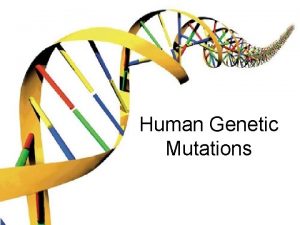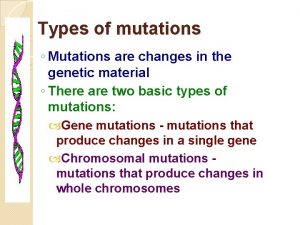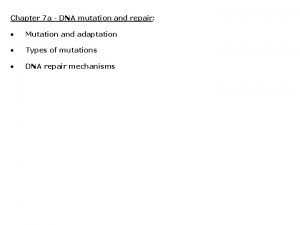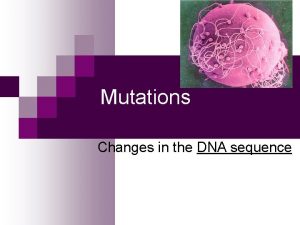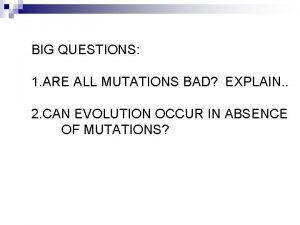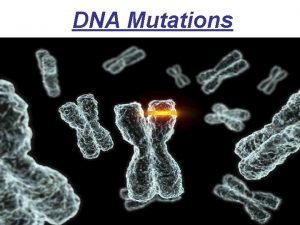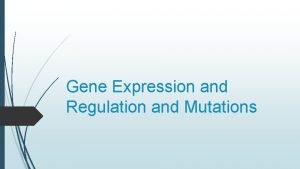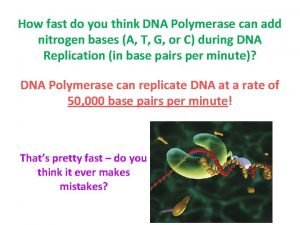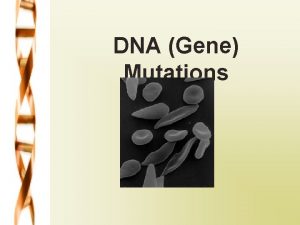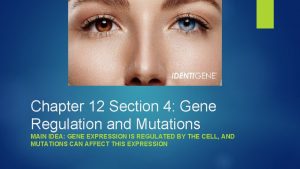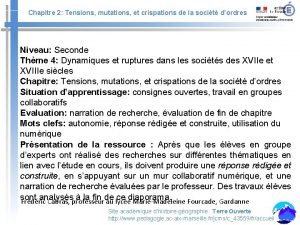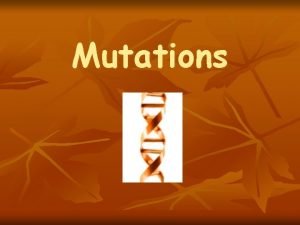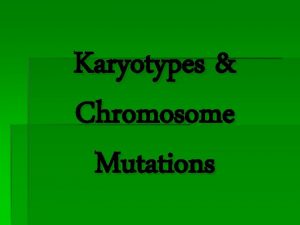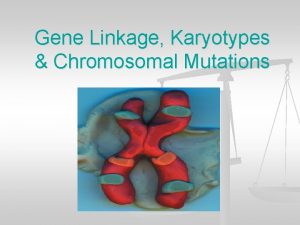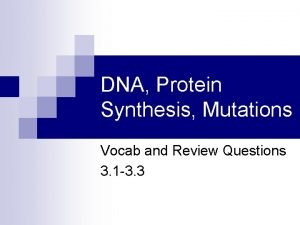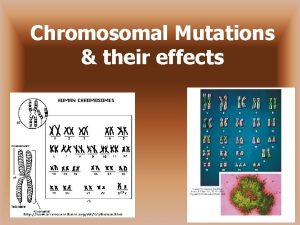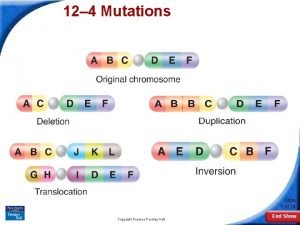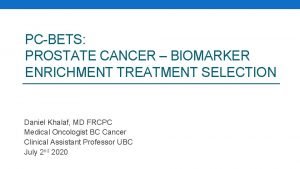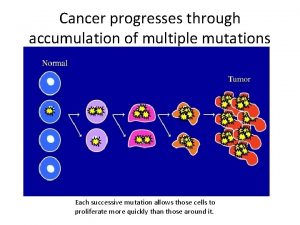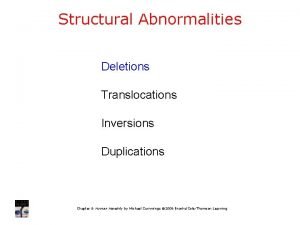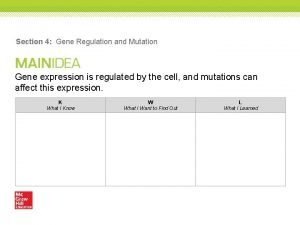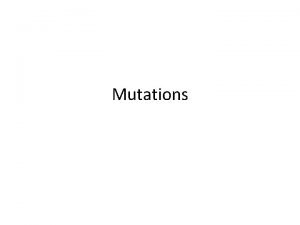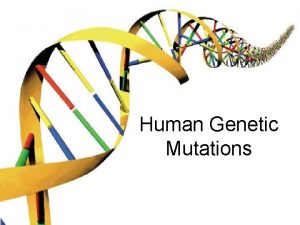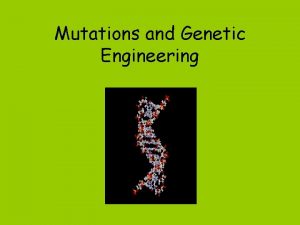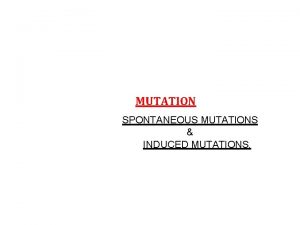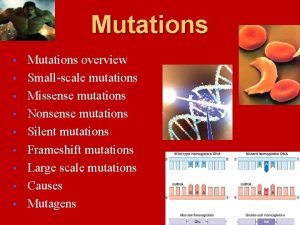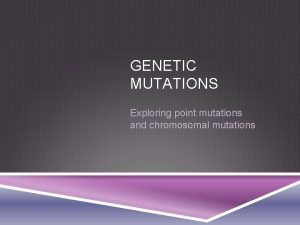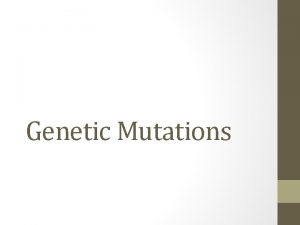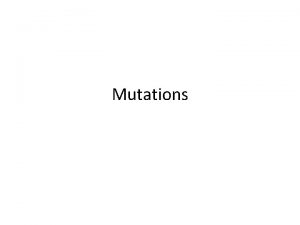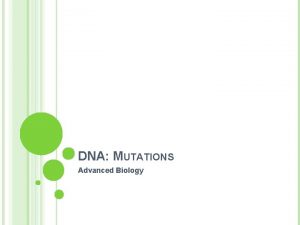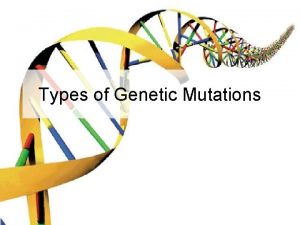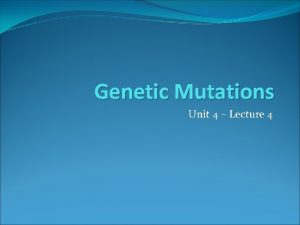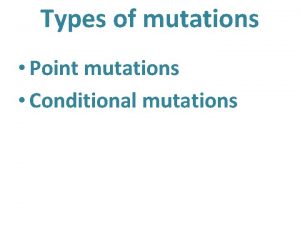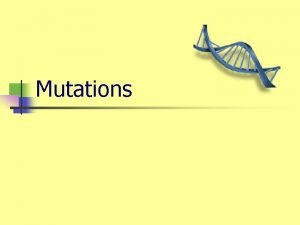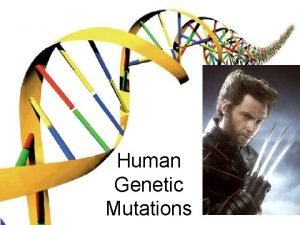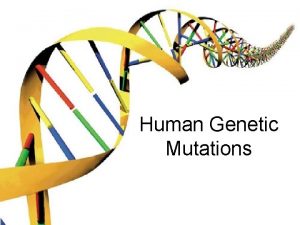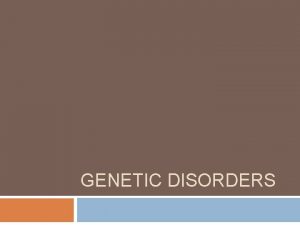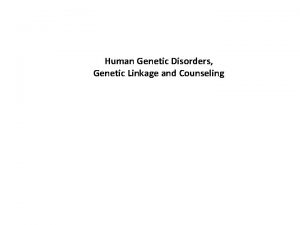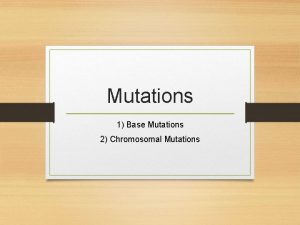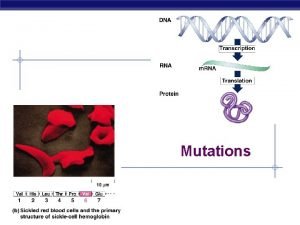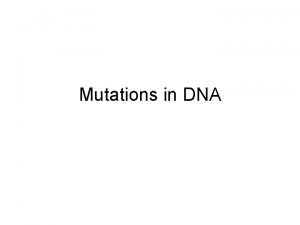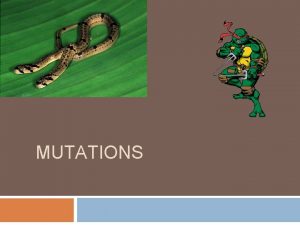Human Genetic Mutations 2 Main Types of Mutations






































- Slides: 38

Human Genetic Mutations

2 Main Types of Mutations 1. ) Chromosomal Mutations 2. ) Gene Mutations

What are chromosomes? • Humans have 23 pairs of chromosomes, with one chromosome from each parent. • The chromosomes are coiled up DNA. • Under normal conditions all of the chromosomes are inherited in tact. This is a norm huma n chro al karyoty p moso is a pi mes. e of cture A kary of chr up to oty o look a moso mes li pe t and ned comp are.

Chromosomal Mutations • Any change in the structure or number of chromosomes • Large scale: Affect many genes

5 Types 1. 2. 3. 4. 5. Deletion Duplication Inversion Translocation Non. Disjunction

Chromosomal Deletion One or more genes are removed Causes: Wolf-Hirschhorn syndrome (severe mental retardation) cri du chat syndrome (mewing sounds, mental retardation)

Chromosomal Duplication A segment of genes is copied twice and added to the chromosome Causes: Charcot–Marie–Tooth disease (high arched foot, claw feet, confined to a wheelchair)

Chromosomal Inversion a segment of genes flip end-to-end on the chromosome Causes: Four-Ring Syndrome (cleft pallate, club feet, testes don’t descend)

Chromosomal Translocation Material is swapped with another chromosome Causes: Burkitt’s Lymphoma (cancer of the lymph nodes, in children)

Nondisjunction • Chromosomes FAIL TO SEPARATE during meiosis • Meiosis I Nondisjunction • Meiosis II Nondisjunction

Nondisjunction • Produces gametes (and therefore a baby) with one missing chromosome or one extra chromosome

Nondisjunction (in Meiosis II)

Fertilization

Nondisjunction • Every cell in that baby’s body will have __ copies of this chromosome instead of___. • This condition is called ______. • Trisomy 21 = Individual has _____ copies of chromosome # ____

Nondisjunction • Every cell in that baby’s body will have 3 copies of this chromosome instead of 2. • This condition is called _____. • Trisomy 21 = Individual has _____ copies of chromosome # ____

Nondisjunction • Every cell in that baby’s body will have 3 copies of this chromosome instead of 2. • This condition is called TRISOMY • Trisomy 21 = Individual has __ copies of chromosome # ____.

Nondisjunction • Every cell in that baby’s body will have 3 copies of this chromosome instead of 2. • This condition is called TRISOMY • Trisomy 21 = Individual has 3 copies of chromosome # 21.

Chromosomal Mutations • Most chromosomal mutations are lethal • If the fetus survives: Tend to cause wide-spread abnormalities • Example: Down Syndrome

Down Syndrome • Cause: Nondisjunction of chromosome 21 • Three copies of chromosome 21 = “TRISOMY 21”

Trisomy 21 - Down Syndrome

Genetic Screening - Amniocentesis

KEY POINT #1 Too much or too little DNA is bad!

Let’s Review What are the 4 types of chromosomal aberrations? Which type of aberration is probably the most damaging?

Onto gene mutations!

Gene Mutations • Small scale: one gene is affected • Any change to the DNA sequence of a gene: Nucleotides/Bases may be added, missing, or changed

Gene Mutations: 2 Types Point Mutation Frameshift Mutation

Point Mutation • One base (A, T, C, or G) is substituted for another • Causes: Sickle-cell anemia • 3 Possible Consequences: – nonsense mutations: code for a stop, which can translate the protein – missense mutations: code for a different amino acid – silent mutations: code for the same amino acid

Frameshift Mutation • One or more bases (A, T, C, or G) are added or deleted • Causes: Cystic Fibrosis • Caused by: – Insertion: adding a base – Deletion: removing a base

Causes of Mutations • spontaneous • occur during DNA replication • Caused by MUTAGENS • physical, ex: radiation from UV rays, X-rays or extreme heat • or chemical (molecules that misplace base pairs or disrupt the helical shape of DNA).

Gene Mutations • KEY IDEA: A mutated gene will make a mutated protein • Mutant proteins are trouble! – They do not go where they are supposed to go – They do not do what they are supposed to do

Example: Sickle Cell Anemia Normal Red Blood Cell Sickle Red Blood Cell • Red blood cells shaped like a disc • Hemoglobin (protien) carries oxygen to all parts of the body • Red blood cells form an abnormal crescent shape • Hemoglobin (protein) is abnormally shaped • don't move easily through your blood vessels • form clumps and get stuck in the blood vessels


Example: Cystic Fibrosis (CF) • What is it? – Autosomal, recessive disorder • Symptoms – Thick mucus in the lungs and digestive track – Constant lung infections and impaired digestion

Cystic Fibrosis (CF) • Who gets it? – Anyone – Most common in Caucasians • Prevalence – 1 in ~3, 000 Americans has CF – 1 in 23 white Americans carries the mutant allele!

Cause of Cystic Fibrosis (CF) • The “CFTR” gene is mutated – 3 base pairs are deleted • Mutant protein is missing an amino acid and cannot fold correctly vs

Normal CFTR protein: Ion channel in cell membrane

KEY POINT #2 Mutation of a gene = Mutant protein Dysfunctional proteins cause the symptoms of the disorder

Review • What are the two major types of genetic mutations? • How are chromosomal aberrations and gene mutations different? • What are the 4 types of chromosomal aberrations? • What are some types of gene mutations?
 Two types of point mutation
Two types of point mutation Founder effect
Founder effect Genetic programming vs genetic algorithm
Genetic programming vs genetic algorithm Genetic programming vs genetic algorithm
Genetic programming vs genetic algorithm Genetic drift vs gene flow
Genetic drift vs gene flow What is the difference between genetic drift and gene flow
What is the difference between genetic drift and gene flow Types of mutations
Types of mutations Mutation and adaptation
Mutation and adaptation Dna types of mutations
Dna types of mutations Silent mutation
Silent mutation 4 types of mutations
4 types of mutations Mutagens
Mutagens Types of mutations
Types of mutations Genetic effects on gene expression across human tissues
Genetic effects on gene expression across human tissues Polyploid
Polyploid The future will
The future will Tell more about the main idea
Tell more about the main idea Void main int main
Void main int main What are some neutral mutations
What are some neutral mutations Dna vs rna worksheet answer key
Dna vs rna worksheet answer key Mutation causes
Mutation causes Chapter 14 lesson 4 mutations
Chapter 14 lesson 4 mutations Chapter 12 section 4 gene regulation and mutations
Chapter 12 section 4 gene regulation and mutations Tensions mutations et crispations de la société d'ordres
Tensions mutations et crispations de la société d'ordres What is a beneficial mutation in humans
What is a beneficial mutation in humans 4 steps of protein synthesis
4 steps of protein synthesis Mutated karyotype
Mutated karyotype Chromosomal mutation
Chromosomal mutation Protein synthesis and mutations
Protein synthesis and mutations Protein synthesis and mutations
Protein synthesis and mutations Chromosomal mutation
Chromosomal mutation 12-4 mutations
12-4 mutations Cancer mutations
Cancer mutations Cancer mutations
Cancer mutations Cancer mutations
Cancer mutations Forward mutation
Forward mutation Translocation mutation
Translocation mutation Section 4 gene regulation and mutations
Section 4 gene regulation and mutations Chromosomal mutations
Chromosomal mutations
